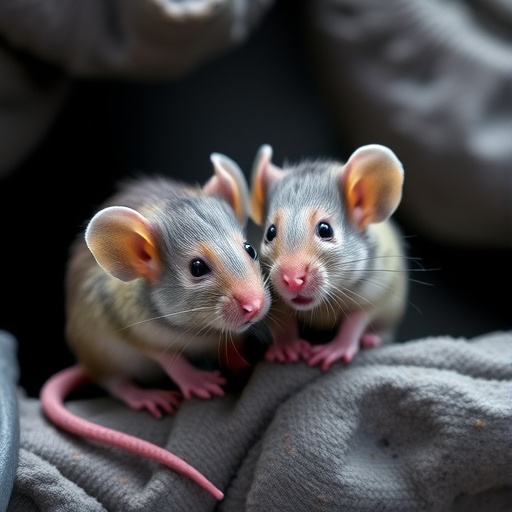Recent research has unveiled striking differences in how male and female mice respond to indomethacin-induced organ injury, alongside potential therapeutic avenues targeting the gut microbiome. This study, conducted by a team of scientists led by Zhang et al., highlights the importance of considering sex as a biological variable in preclinical research and lays the groundwork for future studies that may pave the way for sex-specific treatment modalities for related conditions.
Indomethacin, a widely used nonsteroidal anti-inflammatory drug (NSAID), is known for its efficacy in treating pain and inflammation, especially in conditions such as arthritis. However, its use is often accompanied by adverse side effects, including gastrointestinal toxicity and organ injury. The new findings published in Scientific Reports indicate that the extent of these injuries may not be uniform across sexes. Understanding these differences is critical as they may influence clinical outcomes and the effectiveness of therapeutic strategies.
Zhang and colleagues employed a rigorous experimental design to investigate the physiological responses of mice following indomethacin administration. Utilizing both male and female mouse models, the researchers explored the damaging implications of this NSAID on various organs. Their observations included significant variations in biomarkers of injury and inflammation depending on the sex of the subjects.
The inflammatory response, a natural reaction to injury or infection, can manifest differently in males and females. The team meticulously monitored inflammatory markers and organ function, revealing that female mice exhibited a different pathological response compared to their male counterparts. This disparity brings forth questions about the underlying biological mechanisms that could be influencing these differences.
In exploring the role the gut microbiome plays in health and disease, the researchers hypothesized that it might contribute to the observed sex-dependent responses. The gut microbiome, comprising trillions of microorganisms, is increasingly recognized for its integral role in modulating host immune responses and mediating drug metabolism. In their experiments, the team assessed the microbiome composition of the mice before and after indomethacin treatment.
The results from the microbiome analysis demonstrated significant alterations in microbial communities associated with the inflammatory responses noted in both sexes. Interestingly, certain beneficial bacteria were identified to be more abundant in female mice, suggesting that a more diverse microbiome could offer protective effects against drug-induced organ damage. This highlights the potential for developing microbiome-targeted interventions as adjunct therapies for patients suffering from NSAID-related side effects.
Furthermore, the study proposes that modulating the gut microbiome could serve as a viable strategy to alleviate organ injury induced by indomethacin. By either administering specific probiotics or prebiotics capable of enhancing the growth of protective microbes, researchers could potentially mitigate the adverse effects associated with this commonly prescribed drug. The implications of this approach are vast, particularly as gastrointestinal complications from NSAIDs remain a significant concern among patients.
Aside from focusing on therapeutic strategies, this research also underscores the necessity to reevaluate existing clinical practices. Traditionally, drug development and administration have often overlooked sex differences due to a historical bias favoring male-centric studies. The findings from Zhang et al. usher in a new perspective, advocating for a more inclusive approach that takes into account sex-dependent biological variations.
Moreover, the study emphasizes the need for further research into the mechanisms that underpin the variations in response to treatments between genders. Understanding these pathways not only holds promise for enhancing existing treatment modalities but also for tailoring new therapeutic interventions that consider individual patient profiles based on sex.
As research continues to evolve, the integration of microbiome studies into pharmacology and toxicology represents a pioneering frontier. Zhang and colleagues’ work is a call to action for the scientific community to deepen its understanding of the microbiome and its potential in promoting drug safety and efficacy.
This emerging evidence calls for a significant paradigm shift in how we approach drug testing and development, ensuring that the impacts of gender are adequately represented. The potential for personalized medicine, highlighted by these findings, could ultimately lead to improved health outcomes for all patients.
In conclusion, the innovative research conducted by Zhang et al. serves as a crucial step towards unearthing the complexities of pharmacological responses influenced by sex. The link between the gut microbiome and its protective role against indomethacin-induced injury opens up exciting avenues for future research and development. As we continue to unravel the intricate interplay between gender, drug metabolism, and microbiota, we move closer to ensuring that the benefits of new therapies can be optimized for every individual.
As scientists explore these vital connections in greater depth, the implications extend beyond animal models, suggesting that similar sex-dependent responses may be observed in human patients. Future studies will be pivotal in confirming these hypotheses and providing a foundation for developing therapies that ultimately reduce adverse medication effects across genders while enhancing patient care and treatment efficacy.
Subject of Research: Responses of male and female mice to indomethacin-induced organ injury and the role of the gut microbiome in alleviating these effects.
Article Title: Sex-dependent responses in mice to indomethacin-induced organ injury and gut microbiome-targeted alleviation.
Article References:
Zhang, J., Sekela, J.J., Hutchinson, L.E. et al. Sex-dependent responses in mice to indomethacin-induced organ injury and gut microbiome-targeted alleviation.
Sci Rep 15, 36025 (2025). https://doi.org/10.1038/s41598-025-20020-x
Image Credits: AI Generated
DOI: 10.1038/s41598-025-20020-x
Keywords: Indomethacin, organ injury, sex differences, gut microbiome, inflammation, pharmacology, therapeutic strategies, personalized medicine.
Tags: biomarkers of injury and inflammationgut microbiome solutionsimplications of sex differences in clinical outcomesindomethacin-induced organ injuryNSAID side effects in males and femalesphysiological responses to drugspreclinical research in pharmacologyresearch on mice models in drug studiessex as a biological variablesex differences in micesex-specific treatment modalitiestherapeutic strategies for gastrointestinal toxicity





